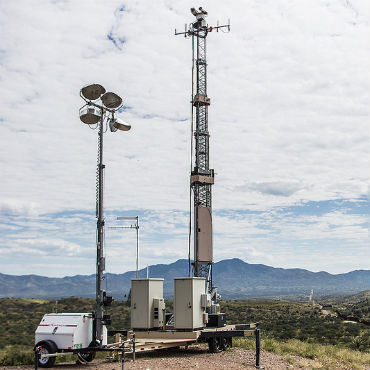CBP's border wall plans integrate tech

Despite funding uncertainty, Customs and Border Protection is moving ahead with designs for a technological and physical barrier along the southern border.

CBP mobile sensor tower near Nogales, Ariz.
Even with funding for President Donald Trump's promised wall along the southern border looming as a flash point in December budget negotiations, Customs and Border Protection is moving ahead with designs for a technological and physical barrier.
"Planning is very much underway" for the hybrid barrier, said CBP chief Ronald Vitiello at a Sept. 12 AFCEA event. "What we've decided on is personnel, technology, infrastructure."
Vitiello said that CBP has learned lessons since SBINet, the Department of Homeland Security's billion-dollar attempt to combine tech and infrastructure to secure the southern border that was abandoned in 2011.
That project, Vitiello said, was based on the premise that they'd begin construction of the physical barrier and "let the tech catch up."
However, the new wall, Vitiello said, will be an "integrated solution" of tech and physical infrastructure from the start, consisting of underground motion sensors that will detect people approaching the border as well as cameras and radar to conduct surveillance.
Deploying unmanned aerial systems was "another area of exploration" for CBP, Vitiello added.
The strategy of building a "smart wall" is based both on learning from past high-profile failures, as well as through meetings with Israeli security officials, who advised CBP to lean more on technology and on private industry, Vitiello said.
"They advised us not to build a wall that's dumb," he said. "We've learned to put the whole package together."
Vitiello said that Trump's executive order provided clarity on the constitution of the wall and that CBP has "very detailed requirements" for fiscal year 2018 and is evaluating plans for years beyond.
At the end of August, CBP tapped four construction firms to build the concrete-version prototypes of the physical infrastructure for the wall, with each award valued around $500,000. The agency said in its Aug. 31 statement that it expects prototype construction to begin "in the fall."
"We are very clear on what we need to do this year and what we will continue to do through [2018], dependent on" Congress's appropriations package, he said.
The overall CBP funding, as drafted in the House Homeland Security appropriations bill, includes $1.6 billion for the physical wall, plus $131 million for new border technology, $106 million for new aircraft and sensors and $100 million for an additional 500 border patrol agents.
So far, Democrats in the Senate have shown no inclination to compromise on wall funding.
Rep. Will Hurd (R-Texas), a longtime skeptic of the border wall, introduced legislation in July that would require DHS to deploy technology where it is the best option and would prevent funding for construction until a comprehensive border strategy, including a cost estimate and justification, is submitted to Congress.
Hurd said the goal of the bill, cosponsored by six Republicans and two Democrats, is to reduce the wall's multibillion-dollar price tag.
Despite the proposed uptick in money for the wall and for agents, Vitiello said CBP is currently "down about 2,000 agents" from where the agency would like to be, in part due to human resources issues, in part due to funding.
"We're not keeping up currently with attrition," he said.


